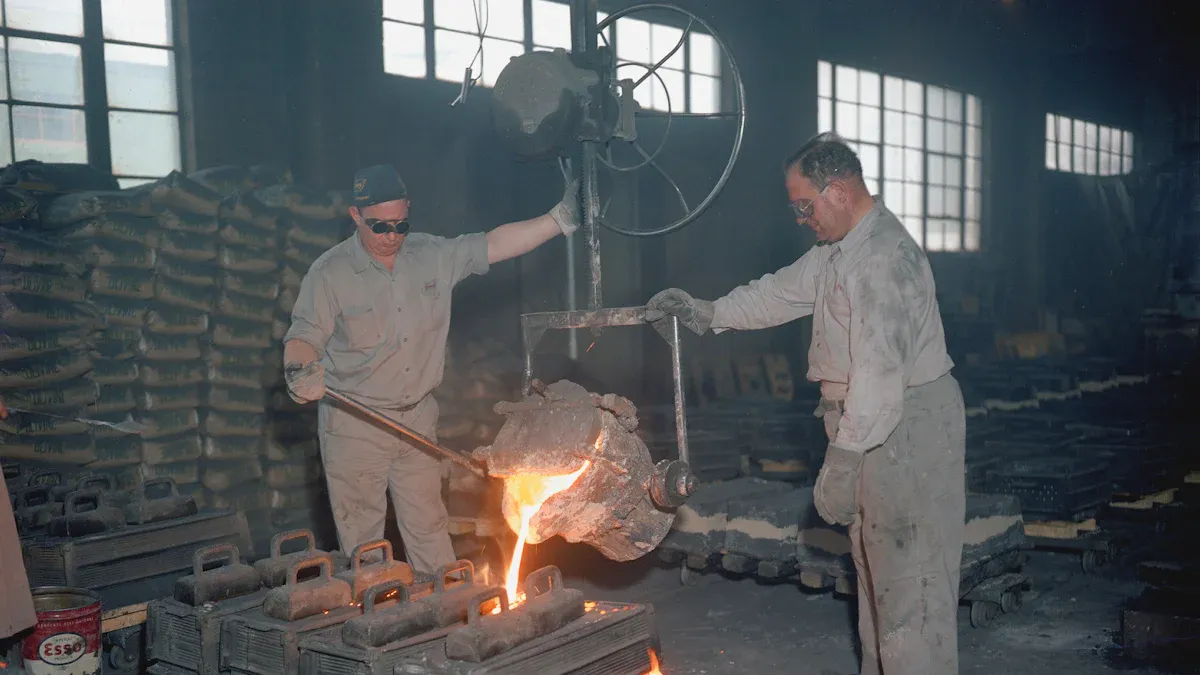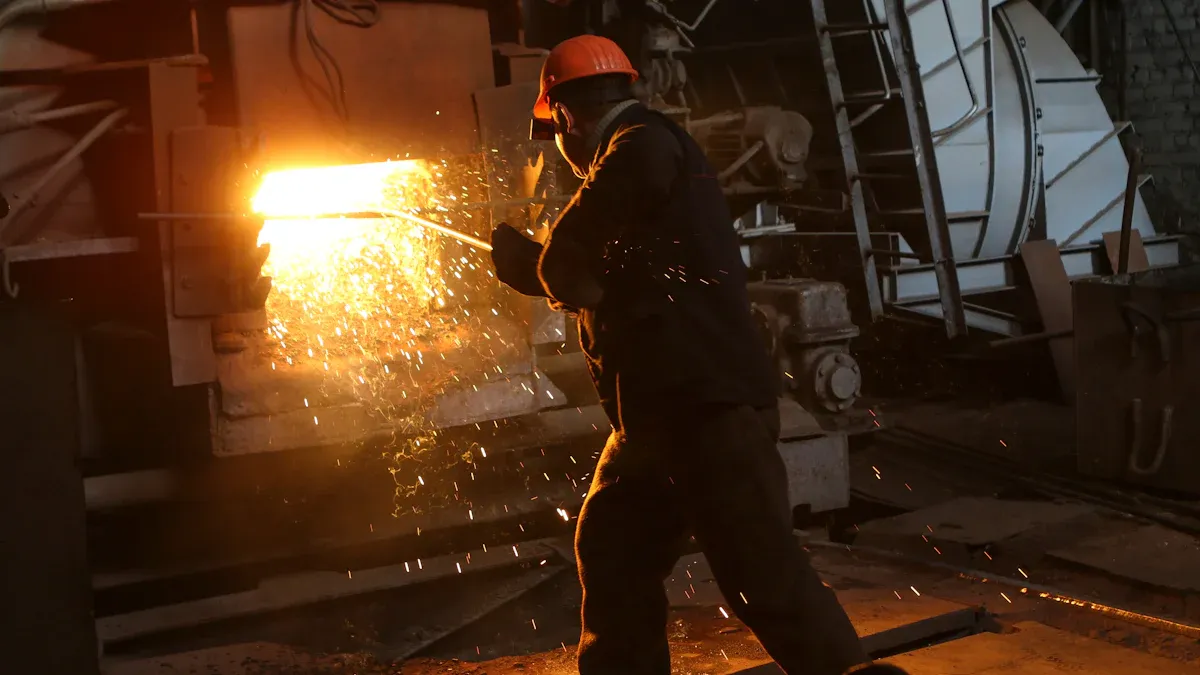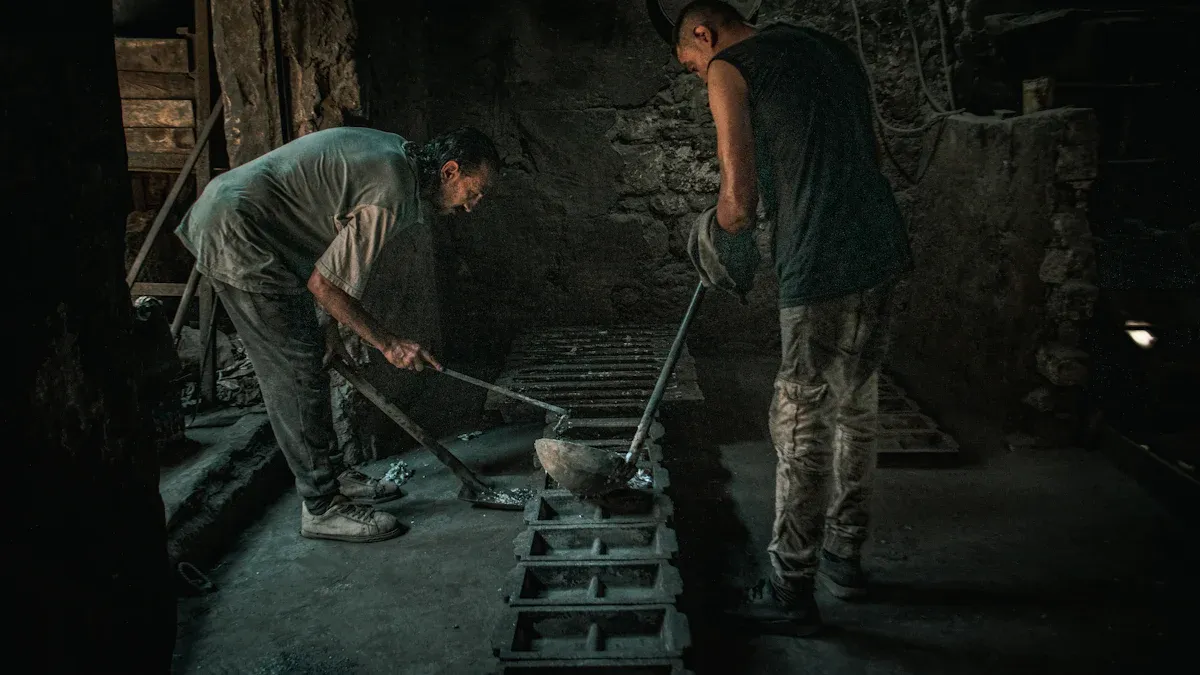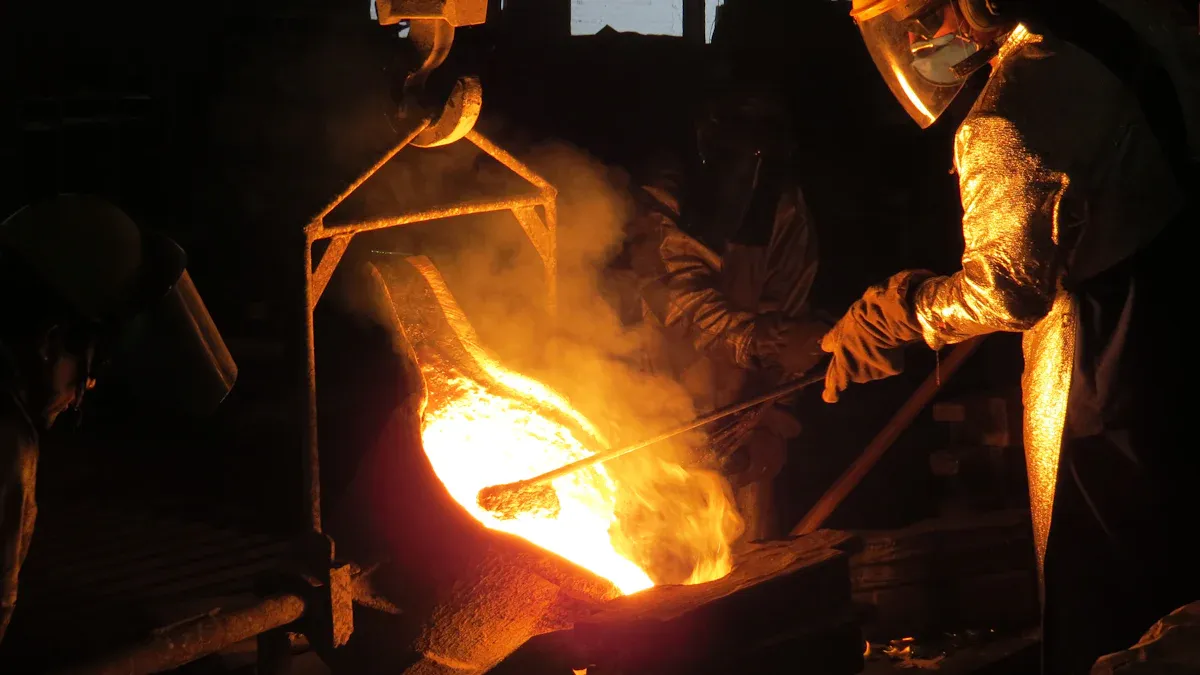
You can figure out sand casting cost by looking at each part. Start by checking the main things that affect your budget. These are material, tooling, labor, and production volume. Every step in sand casting can change your cost. For example, a common alloy costs less than a rare one. Tooling costs a lot at first, especially for hard designs. Labor costs go up if your part needs more steps or skilled workers. How many parts you make changes the price for each one. Here is a simple table that shows how these things change sand casting cost:
| Cost Factor | Impact on Sand Casting Cost |
|---|---|
| Material | Rare alloys cost more than common ones |
| Tooling | Hard designs make starting costs higher |
| Labor | More steps and skill make labor cost more |
| Production Volume | Making more parts lowers the cost per part |
Use a step-by-step way to collect data and figure out each part. This helps you get a clear and correct sand casting cost for your project.
Key Takeaways
- Material, tooling, labor, and how many you make are the main things that change sand casting cost. – Looking at costs for each step helps you see where your money goes and helps you control your budget. – Making more parts makes each part cheaper because you share tooling and labor costs. – Giving clear project details and a good Request for Quote (RFQ) helps suppliers give the right prices. – Checking and comparing supplier quotes helps you get fair prices and avoid surprises.
Sand Casting Cost Factors

When you estimate sand casting cost, you need to look at several main areas. Each area can change your total price. These cost factors for sand casting include material costs, tooling and pattern costs, labor and production, and finishing and overhead. You will see that part shape, how many parts you make, and the finish you want all play a big role.
Material Costs
Material costs make up a large part of your sand casting cost. You pay for the metal, sand, binders, and other additives. The type of metal you choose changes the price a lot. For example, steel costs more than iron, and aluminum costs more than both. You also need to think about the sand and chemicals used to make the mold.
Here is a table that shows common material costs for sand casting:
| Material Category | Specific Material/Type | Cost Range (USD) | Unit |
|---|---|---|---|
| Metals – Steel | Raw steel (various grades) | $600 – $1,500 (up to $2,000+) | per metric ton |
| Per kilogram cost | $0.50 – $1.50 | per kilogram | |
| Metals – Iron | Raw iron (gray, ductile) | $300 – $700 | per metric ton |
| Scrap iron | $150 – $400 | per metric ton | |
| Per kilogram cost | $0.30 – $0.70 | per kilogram | |
| Metals – Aluminum | Per kilogram cost | $2.00 – $4.00 | per kilogram |
| Alloying Elements | Chromium, manganese, silicon | $0.10 – $1.00 | per kilogram |
| Sand | Silica sand | $20 – $50 | per ton |
| Specialty sands (chromite, zircon) | $200 – $500 | per ton | |
| Binders | Clay binders (e.g., bentonite) | $10 – $30 | per ton of sand |
| Chemical binders | $100 – $500 | per ton of sand | |
| Additives | Coal dust, organic compounds | $50 – $200 | per ton |
| Core Materials | Core sand and binders | $50 – $200 | per ton |
| Chemical binders for cores | $100 – $400 | per ton | |
| Core Boxes | Metal or composite molds | $1,000 – $10,000 | per unit |
You will notice that material costs for sand casting can change based on the type and amount of metal you need. If your part is large or uses a rare alloy, your material costs will go up. If you use special sand or more additives, you will also pay more. Always check the latest prices before you start your project.
Tooling and Pattern Costs
Tooling and pattern costs are the upfront costs you pay to make the molds and patterns for your parts. These costs can be high, especially for complex shapes. You pay these costs before you make any parts, so they are important for your budget.
Here is a table that shows typical tooling and equipment costs for sand casting:
| Tooling Aspect | Cost Range (USD) | Production Volume Suitability |
|---|---|---|
| Patterns | $500 – $7,500 | Low to medium volume |
| Sand Casting Molds | $6,000 – $20,000 | Low-volume production |
| Core Boxes | $1,000 – $10,000 | Low to medium volume |
You will find that sand casting tooling is less expensive than other casting methods. If you need to change your design, you can do it without spending too much. Tooling maintenance and storage fees stay low. If you plan to make many parts, your tooling and equipment costs per part will drop.
Tip: If your part has a simple shape, you can save money on patterns and molds. Complex parts need more detailed patterns, which cost more.
Labor and Production
Labor costs are what you pay workers to make your parts. These costs depend on how many steps your part needs and how skilled the workers must be. If your part has a simple shape, labor costs stay low. If your part needs special cores, tight tolerances, or extra steps, labor costs go up.
You also need to think about mold preparation costs. Each mold must be made before you pour the metal. Mold preparation costs can range from $10 to $15 per mold for simple jobs. If your part is complex, mold preparation costs can be higher. Labor costs also include cleaning, inspection, and moving parts around the shop.
If you make more parts, you can spread labor costs over more pieces. This lowers the labor cost per part. If you only make a few parts, labor costs per part will be higher.
Finishing and Overhead
Finishing and overhead costs cover everything after the metal cools. Finishing includes cleaning, grinding, and machining your parts. If you want a smooth surface or tight size limits, finishing costs will rise. Overhead costs include things like shop rent, power, and safety gear.
You should also think about mold preparation costs here. If you need special coatings or extra steps to get the right finish, your mold preparation costs will go up. Overhead costs do not change much with part shape, but they do add to your total sand casting cost.
Note: If you want a better surface finish, you will pay more for finishing and mold preparation costs. Always include these in your estimate.
When you look at all these cost factors for sand casting, you can see how each one affects your project. Material costs, labor costs, mold preparation costs, and tooling and equipment costs all add up. If you plan your project well, you can control your sand casting cost and avoid surprises.
Sand Casting Process Overview
Steps in Sand Casting
You can break down the sand casting process into several clear steps. Each step plays a role in shaping your final part and your total cost. Here is a simple list of the main steps:
- Pattern Creation: You start by making a pattern that matches your part’s shape. This pattern must allow for metal shrinkage.
- Mold Preparation: You pack sand around the pattern to form a mold cavity.
- Core Insertion: If your part needs hollow spaces, you place sand cores inside the mold.
- Mold Assembly: You join the mold halves and secure them.
- Pouring: You pour molten metal into the mold cavity.
- Cooling and Solidification: The metal cools and hardens inside the mold.
- Casting Removal: You break the mold to remove the solid part.
- Finishing: You clean, grind, and machine the casting to meet your needs.
Tip: Each step in the sand casting process can affect your cost and the quality of your part.
Impact on Cost
Every step in sand casting adds to your project’s cost in a different way. Tooling costs come from pattern creation. If your part is complex, you pay more for patterns and core boxes. Mold preparation uses sand and binders, which make up a big part of your material costs. Labor costs rise during mold making and finishing, especially if your part needs extra care.
Melting and pouring costs are highest during the pouring step. You use a lot of energy to melt the metal, and you must control the temperature to avoid defects. If you recycle sand or improve energy use, you can lower both environmental impact and cost.
Defects like porosity or shrinkage often come from poor mold design or mistakes during pouring. These problems lead to more rework and scrap, which increases your total cost. Good process control and quality checks help you avoid these extra expenses.
Here is a table that shows how each cost factor contributes to the total sand casting cost:
| Cost Factor | Approximate Cost Contribution |
|---|---|
| Material | 40-60% |
| Labor | 20-35% |
| Tooling | 5-15% |
| Finishing | 10-25% |
You can see that material and labor make up most of your sand casting cost. Melting and pouring costs also play a big role, especially for large or complex parts. By understanding each step, you can find ways to save money and improve quality in your sand casting project.
Price Estimation Steps
Define Project Requirements
Start your price estimation by writing down what you need for your sand casting project. List the number of parts, the size, and the shape. Decide what metal you want to use. Think about the surface finish and any special features. If you need tight tolerances or hollow spaces, note these details. Clear project requirements help you avoid mistakes later.
You should also ask yourself these questions:
- How many castings do you need?
- What is the weight of each part?
- Do you need a special alloy or a common one?
- Will you need extra machining or finishing?
- Are there any design changes expected during production?
Tip: The more details you gather at the start, the more accurate your sand casting cost estimation will be.
Break Down Each Cost
Now, break down your sand casting costs into smaller parts. This step helps you see where your money goes. Use a table or a cost template to organize your data. Here is a simple way to split the costs:
| Cost Category | What to Include |
|---|---|
| Material Costs | Metal, sand, binders, additives |
| Tooling Costs | Patterns, molds, core boxes, maintenance, storage |
| Labor Costs | Mold making, pouring, finishing, inspection |
| Finishing Costs | Cleaning, grinding, machining |
| Overhead | Utilities, rent, safety equipment |
| Other Costs | Design changes, storage fees, scrap, rework |
You need to check the price for each item. For example, calculate labor costs for every step in the process. If your part needs more finishing, add that to your labor costs. Do not forget to include storage fees for patterns and molds. If you expect design changes, add a budget for those as well.
Many companies use cost templates to make this easier. These templates help you track all-in costs for your sand casting project. You can find free templates online or ask your supplier for one.
Note: Always include long-term costs for sand casting, such as tooling maintenance and possible design changes. Studies show that ignoring these costs can lead to big mistakes in your total price estimation. For example, research on manufacturing tools found that the total cost over a tool’s life can change by more than 70% depending on how you handle maintenance and design updates. This means you should always plan for repairs, downtime, and updates to your patterns or molds.
Calculate Total Cost
Add up all the costs from your breakdown to get the total sand casting cost. This step gives you a clear view of your all-in costs. Use a calculator or spreadsheet to make sure you do not miss anything.
Here is a simple checklist to help you:
- Add up material costs for all parts.
- Include tooling costs, divided by the number of parts if you make many.
- Total all labor costs for each process step.
- Add finishing and overhead costs.
- Include extra costs like storage fees and design changes.
- Review your numbers for mistakes.
Callout: If you make more parts, your tooling and labor costs per part will drop. If you make only a few, each part will cost more.
You should also think about future costs. If you plan to use the same patterns for more projects, spread the tooling costs over more parts. If you expect design changes, keep some budget for updates. This way, your price estimation will stay accurate even if things change.
When you follow these steps, you can build a strong cost estimation for your sand casting project. You will see how each process step and cost factor affects your total price. This helps you make smart choices and avoid surprises.
Working with Sand Casting Suppliers
Requesting Quotes
When you want to start a sand casting project, you need to ask suppliers for quotes. First, write a clear Request for Quote, or RFQ. In your RFQ, list all the details about your sand casting needs. Say how many parts you want and what metal you need. Tell the size of each part. Add your quality rules, how you will check the parts, and what kind of surface finish you want. If you need special packaging or fast shipping, write that in your RFQ too. Suppliers use this information to give you the right price for sand casting. If you forget details, you might get quotes that do not fit your needs.
Comparing Offers
You will probably get quotes from more than one sand casting supplier. When you compare them, do not just look at the price. Use a checklist to help you:
- Check if each quote covers everything you asked for.
- See if the supplier added tooling, machining, and finishing costs.
- Look at how many parts you must order and how that changes the price for each part.
- Review the quality, tolerances, and any extra services.
- Compare how long it takes to get your parts and when they will arrive.
- Check if packaging and shipping are part of the deal.
You can also use cost estimating tools to help you compare the quotes. These tools let you put in your sand casting part details and see how each supplier’s price is made up. This helps you find out what costs the most and make a smart choice.
Validating Estimates
After you look at the quotes, you need to check if the sand casting prices are correct. Many people use market research and data to test the supplier’s numbers. They might do interviews, look at data, or use math models to see if the prices make sense. These ways help you know if the sand casting prices are fair and a good deal. You can also talk to experts or ask other customers for their opinions. If you do these things, you are less likely to pay too much or get bad quality.
Tip: Always check your sand casting prices again before you pick a supplier. Careful checking helps you avoid big mistakes.
You can figure out sand casting cost by looking at each step. It helps to know what each cost factor is. Using cost estimation models shows how material and energy are used. This makes it easier to pick the best plan for your project. Make sure you write clear RFQs and talk to different suppliers. Check your sand casting cost estimates often, especially if your project changes.
FAQ
How do you lower sand casting costs?
You can lower costs by choosing simple part designs. Use common metals. Increase your production volume. Ask your supplier about reusing patterns or molds. Always check if you can reduce finishing steps.
What is the biggest cost in sand casting?
Material costs usually make up the largest part of your budget. Labor and finishing also add up. If you use rare metals or need tight tolerances, your costs will rise.
Do you pay tooling costs every time?
You pay tooling costs once at the start. If you make more parts, the cost per part drops. You may pay extra for repairs or design changes later.
Can you reuse sand in sand casting?
Yes, you can often reuse sand. Reusing sand helps you save money and reduce waste. You may need to add new binders or clean the sand before using it again.
What details should you include in an RFQ for sand casting?
Always list part size, metal type, quantity, surface finish, and any special features. Add your quality needs and delivery time. Clear details help suppliers give you accurate quotes.




